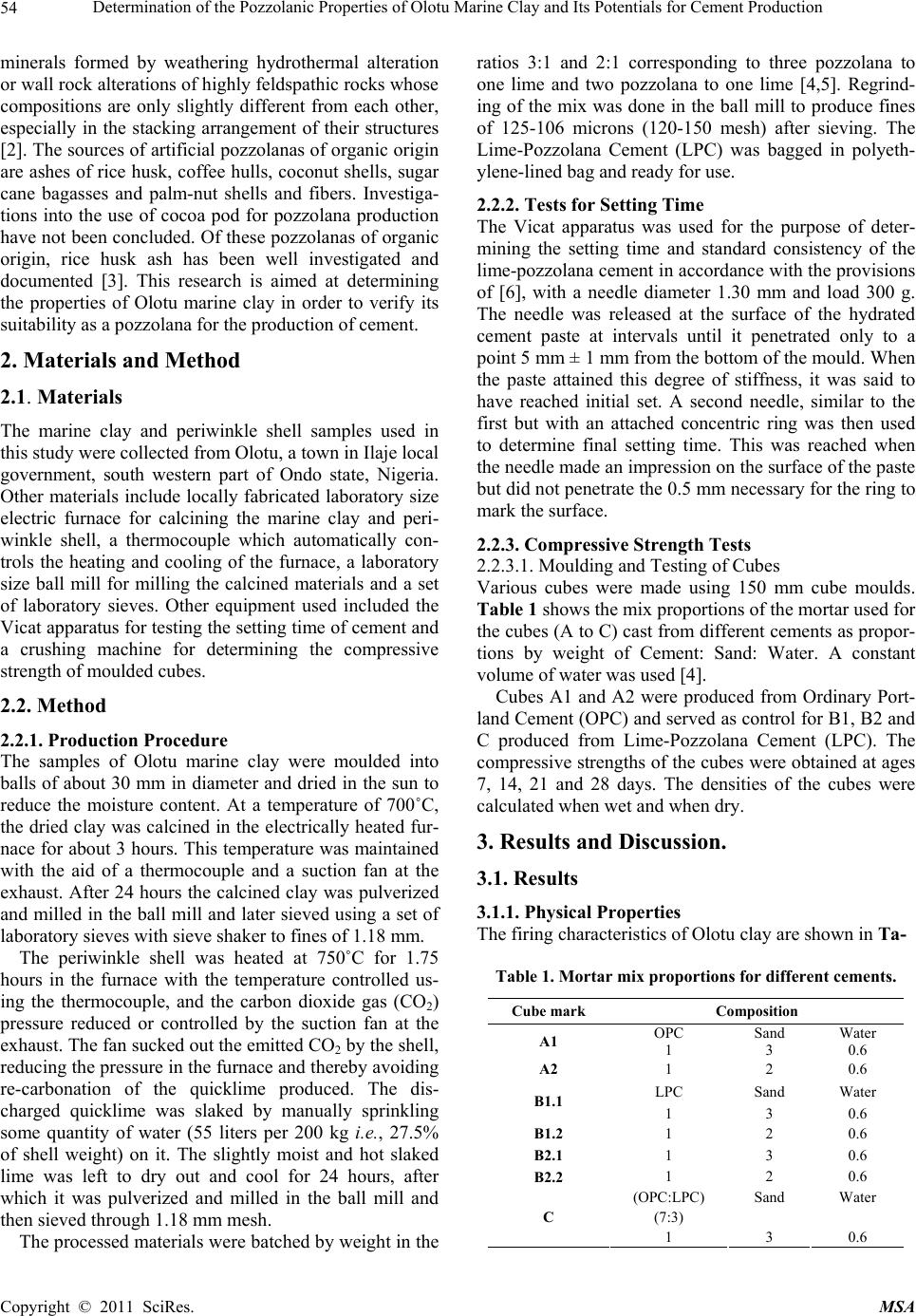
Determination of the Pozzolanic Properties of Olotu Marine Clay and Its Potentials for Cement Production
54
minerals formed by weathering hydrothermal alteration
or wall rock alterations of highly feldspathic rocks whose
compositions are only slightly different from each other,
especially in the stacking arrangement of their structures
[2]. The sources of artificial pozzolanas of organic origin
are ashes of rice husk, coffee hulls, coconut shells, sugar
cane bagasses and palm-nut shells and fibers. Investiga-
tions into the use of cocoa pod for pozzolana production
have not been concluded. Of these pozzolanas of organic
origin, rice husk ash has been well investigated and
documented [3]. This research is aimed at determining
the properties of Olotu marine clay in order to verify its
suitability as a pozzolana for the production of cement.
2. Materials and Method
2.1. Materials
The marine clay and periwinkle shell samples used in
this study were collected from Olotu, a town in Ilaje local
government, south western part of Ondo state, Nigeria.
Other materials include locally fabricated laboratory size
electric furnace for calcining the marine clay and peri-
winkle shell, a thermocouple which automatically con-
trols the heating and cooling of the furnace, a laboratory
size ball mill for milling the calcined materials and a set
of laboratory sieves. Other equipment used included the
Vicat apparatus for testing the setting time of cement and
a crushing machine for determining the compressive
strength of moulded cubes.
2.2. Method
2.2.1. Production Procedure
The samples of Olotu marine clay were moulded into
balls of about 30 mm in diameter and dried in the sun to
reduce the moisture content. At a temperature of 700˚C,
the dried clay was calcined in the electrically heated fur-
nace for about 3 hours. This temperature was maintained
with the aid of a thermocouple and a suction fan at the
exhaust. After 24 hours the calcined clay was pulverized
and milled in the ball mill and later sieved using a set of
laboratory sieves with sieve shaker to fines of 1.18 mm.
The periwinkle shell was heated at 750˚C for 1.75
hours in the furnace with the temperature controlled us-
ing the thermocouple, and the carbon dioxide gas (CO2)
pressure reduced or controlled by the suction fan at the
exhaust. The fan sucked out the emitted CO2 by the shell,
reducing the pressure in the furnace and thereby avoiding
re-carbonation of the quicklime produced. The dis-
charged quicklime was slaked by manually sprinkling
some quantity of water (55 liters per 200 kg i.e., 27.5%
of shell weight) on it. The slightly moist and hot slaked
lime was left to dry out and cool for 24 hours, after
which it was pulverized and milled in the ball mill and
then sieved through 1.18 mm mesh.
The processed materials were batched by weight in the
ratios 3:1 and 2:1 corresponding to three pozzolana to
one lime and two pozzolana to one lime [4,5]. Regrind-
ing of the mix was done in the ball mill to produce fines
of 125-106 microns (120-150 mesh) after sieving. The
Lime-Pozzolana Cement (LPC) was bagged in polyeth-
ylene-lined bag and ready for use.
2.2.2. Tests for Setting Time
The Vicat apparatus was used for the purpose of deter-
mining the setting time and standard consistency of the
lime-pozzolana cement in accordance with the provisions
of [6], with a needle diameter 1.30 mm and load 300 g.
The needle was released at the surface of the hydrated
cement paste at intervals until it penetrated only to a
point 5 mm ± 1 mm from the bottom of the mould. When
the paste attained this degree of stiffness, it was said to
have reached initial set. A second needle, similar to the
first but with an attached concentric ring was then used
to determine final setting time. This was reached when
the needle made an impression on the surface of the paste
but did not penetrate the 0.5 mm necessary for the ring to
mark the surface.
2.2.3. Compressive Strength Tests
2.2.3.1. Moulding and Testing of Cubes
Various cubes were made using 150 mm cube moulds.
Table 1 shows the mix proportions of the mortar used for
the cubes (A to C) cast from different cements as propor-
tions by weight of Cement: Sand: Water. A constant
volume of water was used [4].
Cubes A1 and A2 were produced from Ordinary Port-
land Cement (OPC) and served as control for B1, B2 and
C produced from Lime-Pozzolana Cement (LPC). The
compressive strengths of the cubes were obtained at ages
7, 14, 21 and 28 days. The densities of the cubes were
calculated when wet and when dry.
3. Results and Discussion.
3.1. Results
3.1.1. Physical Properties
The firing characteristics of Olotu clay are shown in Ta-
Table 1. Mortar mix proportions for different cements.
Cube mark Composition
OPC Sand Water
A1 1 3 0.6
A2 1 2 0.6
LPC Sand Water
B1.1 1 3 0.6
B1.2 1 2 0.6
B2.1 1 3 0.6
B2.2 1 2 0.6
(OPC:LPC) Sand Water
(7:3)
C
1 3 0.6
Copyright © 2011 SciRes. MSA